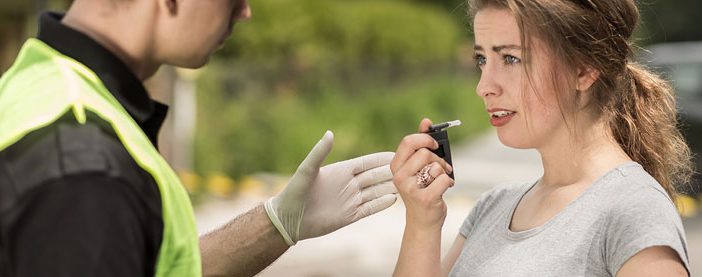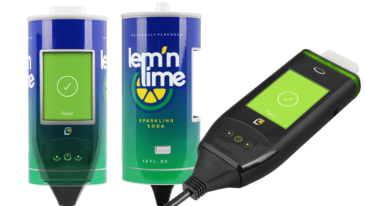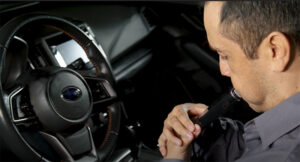
How Long Does a Breathalyzer Detect Alcohol?
Used by law enforcement and in ignition interlock devices, breathalyzers have become the primary tool for detecting the presence of alcohol and measuring a person’s blood alcohol concentration when taking a blood test or urine sample may be too difficult at that moment in time.
They can be an impactful tool in discouraging and preventing alcohol-impaired driving and any injuries, deaths, or property damage resulting from it. Many people wonder how long breathalyzers detects alcohol on your breath. Read on to learn more on how ignition interlock devices work.
Breathalyzers and BAC
Breathalyzers work by measuring your blood alcohol concentration, which is expressed as a percentage that equates to the weight of ethanol in grams for every 100 milliliters of blood. For example, a BAC of 0.08 means 0.08 grams of alcohol per 100 milliliters of blood.
But how can breathalyzers determine your blood alcohol concentration through your breath? When you drink an alcoholic beverage, the alcohol does not get broken down immediately, and it enters your bloodstream without any real changes to its chemical structure. This allows the substance to flow throughout your body along with your blood.
Factors Influencing Detection
Several factors can influence the variability in breathalyzer detection time and accuracy. These factors include individual metabolism rates, sex differences, body fat percentage, age, weight, and height. Additionally, external factors such as recent alcohol consumption, dehydration, and mouthwash use can affect the reliability of breathalyzer test results. In cases where a breathalyzer test provides an incorrect or inconclusive result, alternative tests such as blood, urine, and hair analyses may be necessary to confirm alcohol intoxication. Understanding these factors is essential for interpreting breathalyzer test results accurately and ensuring fair and effective enforcement of alcohol-related laws.
How Do Ignition Interlock Devices Work?
When you drink alcohol, about 20 percent moves directly into your bloodstream fairly intact, while the other 80 percent goes to your small intestine before entering your blood vessels. Alcohol also happens to be highly volatile, meaning that it can easily evaporate given your body’s natural temperature. As your blood flows into and around your lungs, some of the alcohol evaporates and gets trapped in small sacs throughout your lungs known as alveoli. As you exhale, the alcohol stuck in your alveoli exits with your breath. Your breath alcohol level has a direct relation to the amount of alcohol in your blood. About 2,100 milliliters of alveolar air contains the same concentration of alcohol as 1 milliliter of your blood.
The modern ignition interlock device for cars works using a complex fuel cell system. The fuel cell comprises two platinum electrodes sandwiching an acid-electrolyte material. When you breathe into an ignition interlock device, one of the platinum electrodes oxidizes alcohol in your breath and breaks it down into acetic acid, electrons, and protons.
The electrons go through a wire leading to the other platinum electrode and an electrical current meter. The protons enter the lower chamber of the fuel cell to combine with oxygen and the electrons to form water. This creates an electrical current, which increases based on the number of electrons and water (a natural conductor). Essentially, the more alcohol in your system, the higher the electrical current level. Microprocessors within the device measure the electricity levels and calculate it into a blood alcohol concentration reading.
But how can a breathalyzer determine your blood alcohol concentration through your breath? When you drink an alcoholic beverage, the alcohol does not get broken down immediately, and it enters your bloodstream without any real changes to its chemical structure. This allows the substance to flow throughout your body along with your blood.
Breathalyzers work in various mechanisms to measure the alcohol in your alveolar air.
How Long Can a Breathalyzer Test Detect Alcohol On Your Breath?
So then, how long after drinking can you use an Ignition Interlock? It’s important to understand that you cannot “beat” a breathalyzer. Breathalyzers are highly accurate and reliable given regular maintenance and calibration, both of which are required if you use a car breathalyzer. Really, the question of how long does breathalyzer detects alcohol comes down to how you metabolize alcohol.
Once alcohol enters your body and bloodstream, it can only exit through two means. About 10 percent leaves through your urine, breath, and sweat. The other 90 percent is metabolized naturally in the body. The rate of metabolism can differ based on a wide range of factors, but experts generally agree that it takes one hour to break down 0.015 of blood alcohol concentration, meaning that for every hour that you are not drinking, your BAC will go down by 0.015.
One standard drink (which is considered any drink containing 14 grams of alcohol) will increase your BAC by a maximum of 0.02, based on your body size, gender, and other factors. Within about an hour, your blood alcohol concentration would be at almost zero. The problem usually comes when you drink at a faster rate or otherwise drink several alcoholic drinks at once (like taking several shots). Your liver cannot process alcohol that quickly, causing it to accumulate in your blood and leading to a higher BAC. For the average person, it only takes about three or four drinks in one hour to reach a BAC of 0.08.
Given the general rule, if your blood alcohol content is at the limit of 0.08, it would go down to 0.065 after one hour. It would take roughly five hours and twenty minutes for your body to completely metabolize the alcohol and eliminate it from the body. That’s also why it can be dangerous to drink too late into the night. If you have a high enough BAC, you may still actually be drunk when you wake up, which can still be a real problem if you have to drive to work. Those who have been binge drinking can have alcohol in their systems for over 10 hours.
Breathalyzers can detect alcohol within 15 minutes of your first drink and can continue for as long as the alcohol is in your system. Coffee, cold showers, and “sleeping it off” will not sober you up. Time is the only thing that can lower your BAC, so be smart about your alcohol consumption and always have a backup plan to get home.
Breath Alcohol Testing Detection Window
A breathalyzer is a highly sensitive device capable of detecting alcohol on the breath for an extended period, typically up to 24 hours. However, the duration of detection can vary depending on individual factors such as metabolism, sex, body fat percentage, age, weight, and height. Factors influencing detection time include the quantity of alcohol consumed, the rate of metabolism, and the sensitivity of the breathalyzer device used. It’s important to note that while breathalyzers are effective tools for detecting alcohol impairment, they may not always provide accurate results, especially if factors such as dehydration or recent mouthwash use affect the breath sample.
Dangers of Drinking and Driving
Drinking and driving pose significant risks to public safety, leading to a multitude of adverse consequences. The dangers associated with this behavior include an increased risk of car accidents, injuries, chronic diseases, and alcohol poisoning. The effects of alcohol impairment on driving abilities can be profound, impairing judgment, reaction time, coordination, and concentration. Breathalyzer tests play a crucial role in identifying impaired drivers and enforcing laws against drunk driving. By raising awareness of the risks and consequences of drinking and driving, we can work towards preventing accidents and promoting safer roads for everyone.
When Is It Safe to Use Your Ignition Interlock Device?
There isn’t an easy answer to this question. The real answer is that you can use your ignition interlock device when you don’t have any alcohol in your system. The actual time that takes can vary based on the rate at which you metabolize alcohol and the amount of alcohol that you drink.
The general rule is that it takes one hour for your liver to fully break down one drink. That can be helpful in keeping track of your drinking and pacing yourself. However, when you drink more than one drink per hour, the excess alcohol gets stored in your blood and muscle tissue until your liver can handle it. This inevitably leads to a higher BAC and more time required to bring that BAC down. A blood alcohol concentration of 0.08 should take about five hours to clear your system.
Alcohol Use Disorder and Alcohol Poisoning
Alcohol use disorder (AUD) is a chronic medical condition characterized by compulsive alcohol consumption despite adverse consequences. Risk factors for AUD include genetic predisposition, environmental influences, and underlying mental health conditions. Symptoms of AUD may include excessive drinking, loss of control over drinking behavior, and withdrawal symptoms when alcohol consumption is reduced or discontinued. In severe cases, alcohol poisoning can occur, leading to life-threatening complications such as respiratory depression, coma, and death. It’s essential to seek emergency medical attention if someone shows signs of alcohol poisoning, such as confusion, vomiting, seizures, or unconsciousness. Treatment options for AUD may include behavioral therapy, medication, and support groups aimed at promoting sobriety and improving overall well-being.



